Impedance
Injector impedance describes the electrical resistance of the solenoid windings. These are usually grouped in two categories: |
| Low- 1.7 to 3.0 ohms (Peak and Hold Driver/Injectors) |
High- 10 to 16 ohms (Saturated Circuit Drivers/Injectors) |
| These type of injectors and drivers may also be called current sensing or current limiting. They are more expensive and complex than saturated circuit drivers, and are not generally used with domestic production ECUs. They are primarily used in aftermarket high performance systems. Most high flow injectors are low resistance (2-5 ohms) and use a peak and hold driver to activate them. The Peak current is the amount required to quickly jolt the injector open, and then the lower Hold current rating is used to keep it open for as long as the ECU commands. These require the extra kick from the higher current to keep the opening and closing time of the injector stable at the higher fuel flow rate. With this type of driver, 12 volts is still delivered to the injector, but due to the its low resistance, the current in the driver circuit is high. How high? Using Ohms's Law we can calculate the current rating (12v/2 ohms = 6 amps). This is substantial current flow and a Saturated Injector cannot handle it. The drivers also come in two values; 4 amp peak/1 amp hold, and 2 amp peak/0.5 amp hold.. Even though 6 amps may be available to operate the injector, the maximum it is allowed to reach is 2 or 4 amps, depending on the driver's current limit. |
Most domestic OE production EFI systems use an ECU with 12 volt Saturated Circuit drivers. These are very inexpensive, simple, and reliable. This type of driver works by supplying 12 volts to the injectors and the ECU turns it on and off to establish a fuel injector pulse. In general, if an injector has a high resistance specification (12-16 ohms) the ECU uses a 12 volt saturated circuit driver to control it. This means that the current flow in the driver and injector circuit stays low keeping the components nice and cool for long life. Conversely, a downfall of a Saturated Circuit driver is that it has a slower response time (and closing time) than a peak and hold type. This slower time can somewhat decrease the usable operating range of the injector energized by this driver. An injector operating on a saturated circuit driver typically has a reaction time of 2 milliseconds while a peak and hold driver typically responds in 1.5 ms. |
| There are some exceptions to this, notably the Bosch 803 injector used on the Porsche 944 turbo which is 4.7 ohms. Most manufacturers have used both types at one time or another. The trend lately is to use high impedance types in most production cars. The best way to determine impedance is to put a digital ohmmeter across the two electrical connections and see what it reads. The primary advantage of low impedance injectors is a shorter triggering time. When large injectors are fitted to high output engines, low impedance injectors will often give a better idle quality because of this fact. The primary advantage of high impedance injectors is the fact that less heat is generated in the drive circuit and often no external resistors are used. |
Nozzle Types
There are essentially 3 different types of nozzles: |
Pintle
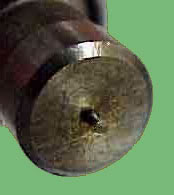
This is the most common type and still the best. A tapered needle sits on a tapered seat. When the solenoid is energized, the core and needle is pulled back, allowing the fuel to discharge. This design has been well proven for over 30 years.
|
Disc
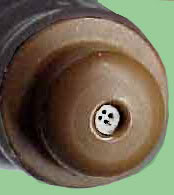
Bosch disc injector |
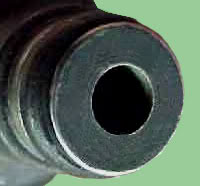
Lucas disc injector |
The Bosch disc type uses the same type of actuation mechanism as the pintle type but replaces the pintle with a flat disc and a plate with tiny holes. These work fine with a good spray pattern but are slightly more prone to deposits plugging the holes. The Lucas type buries the disc up inside the body to reduce the mass of the assembly for quicker response. The Lucas types typically have a very narrow spray pattern which can affect idle and throttle response in some cases.
|
Ball
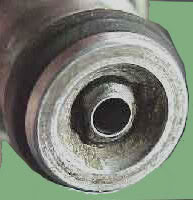
The Rochester division of GM makes the ball type injector for OE applications as well as the larger flow race types for MSD. These use a ball and socket arrangement. These have excellent atomization and a wide spray pattern but are also prone to partial plugging by varnish deposits.
|
Electrical Connections
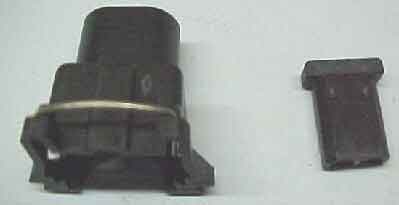
L-jet connector left, D-Jet right
For the majority of injectors, there are two types of electrical connections. The D-Jetronic type used from 1967 to 1973 or so on Bosch injectors in which the plug fits internally into the injector and the L-Jetronic type in which the plug fits over the injector offreing a waterproof seal. Most injectors of all brands built after 1974 use the later type. Unfortunately, several Japanese manufactuers, notably Subaru and Toyota decided to make their own style connectors in the late '80s. These use an oval shaped plug. The D-Jet type will fit most types but is not waterproof.
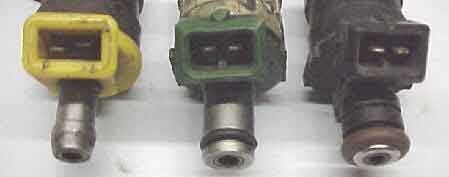
D-Jet left, L-Jet middle/right, Barb left, small O-ring middle, 14mm Domestic O-ring right
Fuel Transfer and Sealing
Fuel transfer from the fuel rails was done with barb fittings and hose on early injectors as shown on the left above or small or large O-rings as shown above on the right. The later type uses a rigid fuel rail to hold the injectors down to the manifold as well as seal to the O-rings.
Sealing injectors to the intake manifold usually involves one of two methods. Older type injectors used a square section O-ring slid over the pintle cap to sit against the steel injector body. Newer injectors use a 14mm round section O-ring sitting in an isolated groove. Some new engines use side inlet injectors, notably Subaru, Nissan and some Ford/Mazda engines. These are not compatible with other types.
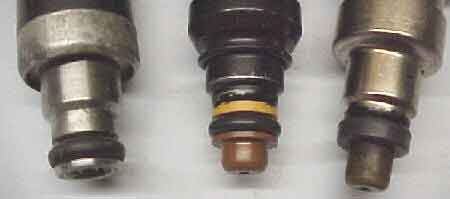
Manifold end 14mm round O-rings left and middle, older square section right
Flow Rates/ Pressure
Most OE injectors are quite small because stock power outputs are usually quite low on production engines and metering is more precise with small injectors for better idle and emissions. Very few production engines use an injector flowing more than 500cc/minute or 50lbs./hr. For performance applications, engines often require much larger injectors to satisfy the increase in fuel flow. Often larger OE injectors can be fitted from a different engine. Sometimes aftermarket ones must be used. MSD makes 50, 72 and 96 lb./hr. types for racing which are popular. It is essential that you have injectors large enough to feed your engine at maximum power. Most OE systems maintain a fuel pressure of between 36 and 43.5 psi over the intake manifold pressure. Fuel pressure can be raised to increase the rate of fuel flow but this should not exceed 60 psi in most cases. It takes 4 times the fuel pressure to double fuel flow. Raising the pressure to extreme levels is very hard on the pump and can lead to leaks or failures in the plumbing and injectors themselves. Use the proper flow rate for the intended application. If you plan to fit used injectors to a performance engine, always have them flow and leak tested first. If they are not in proper condition, the engine will never run well.
Gallery
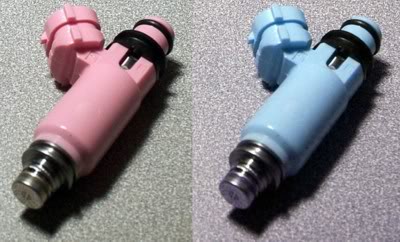
2002-up Subaru WRX STi 500cc Pink -- 2002-up Subaru WRX 380cc Baby Blue |

240SX 260cc, small O-ring, 13.8 ohm |
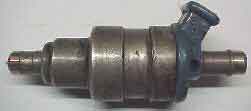
Bosch 036 480cc, barb, 2.2 ohm |
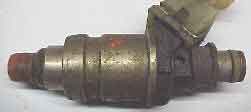
Keihan |
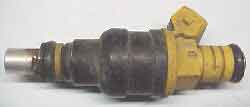
Bosch 711 |
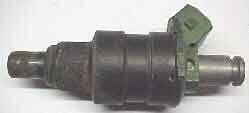
Nippondenso small O-ring Nissan |
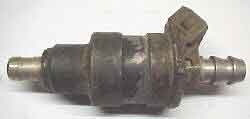
Nippondenso barb |
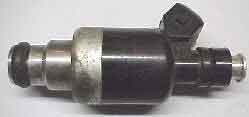
Rochester domestic O-rings |
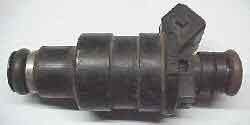
Lucas domestic O-ring |
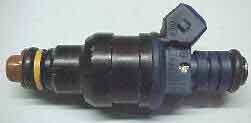
Bosch domestic O-rings |
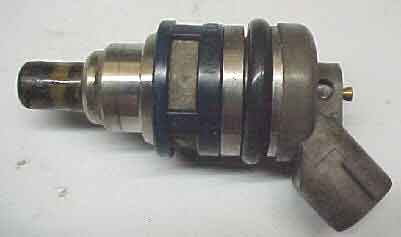
Subaru side feed injector |
|


